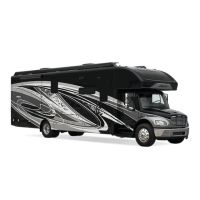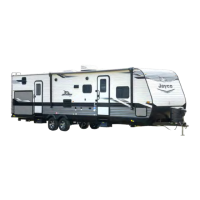57
. If you have further concerns
contact your dealer.
For detailed safety and operating information, refer to the manufacturer’s owner’s manual.
Some converters may be equipped with a charge wiz-
ard There are (3) possible charging modes; NORMAL,
BOOST and STORAGE. The charge wizard will auto-
matically select the best mode to charge your battery. A
green LED next to the wizard mode button will indicate by
ashes, which mode is currently being used.
Green LED ashes once per second; bat-
tery is between 50% and 90% charged. Green LED ashes
2-3 times per second; battery is 90% charged. Output volt-
age is 13.6VDC and the converter is safely completing the
charge of the battery.
Green LED is on solid. Output voltage is 14.4VDC to rapidly charge the bat-
tery up to 90% of full charge.
: Green LED ashes every 6-8 seconds. Output voltage has been reduced to
13.2VDC; the RV battery is fully charged and converter is maintaining the charge.
The manual mode button is used to override the
charge wizard. Refer to the converter owner’s manual for additional information.
Reverse polarity fuse(s) provide protection for the converter
when a battery is used. If the battery is connected backwards to the fuse board a fuse will
blow preventing damage to the converter. Four easily accessible fuses are located next to
the wizard button. Replace with fuses of the same type and rating.
12-volt DC System
Your motor home lighting is powered by 12-volt electricity. The 12-volt DC system is com-
posed of components that will operate when the following conditions are met:
The house batteries power all interior 12-volt components including the lighting
xtures, water pump, 12-volt motors, 12-volt appliances, etc., when the motor
home is not connected to a 120-volt power source.
12-volt DC power is supplied when the shore power cord is plugged into a 120-
volt external power source. House batteries will be charged also in most situa-
tions.
Power is supplied by the chassis alternator when the chassis engine is running.
The 12-volt fuse panel is labeled to indicate fuse sizes, positions and the components pow-
ered. Fuses are located in the load center.
Replacement fuses must be of the same voltage, amperage rating and type.
doing so may cause a re by
overheating the RV wiring.

